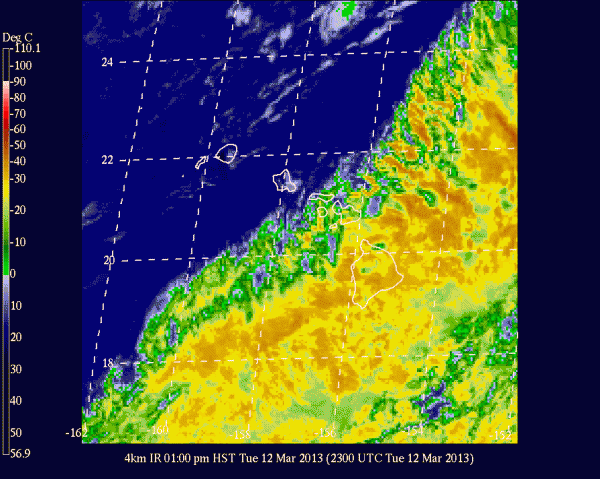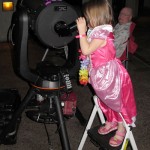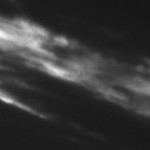So, the comet is to be positioned right next to a pretty crescent moon this evening, a perfect photo opportunity. What are my chances of seeing it? Pretty much nil.
Will have to wait for the photos from my friends in Arizona.

When you want to see the stars, find someplace dark
So, the comet is to be positioned right next to a pretty crescent moon this evening, a perfect photo opportunity. What are my chances of seeing it? Pretty much nil.
Will have to wait for the photos from my friends in Arizona.

I got pleasant surprise walking past the newspaper box on my way to lunch. The Honolulu Star-Advertiser published one of my photos across the top of the front page!

This is not actually one photo, but a panorama assembled from several shots. It was a nice night, if very cold, the first light of dawn just visible on the eastern horizon. Overhead the laser competed with the light of a bright moon. We were doing tests of the newly commissioned Keck 1 laser when I had a chance to get up on the roof and take some photos. Over the radio I begged Heather to lower the bottom shutter on Keck 1 so I could see the telescope inside the dome. I then took about 15 thirty second shots spanning the full view from our roof.
As cold as it was to shoot, it was also a pain to assemble, I worked on this one for hours to get it right. Only about 180° is shown on the newspaper, the original is a full 360°. The result was worth the effort, for your viewing pleasure I have re-posted the full version below. Click on the image to get a larger version…

Presenting the wonders of the night sky to the general public can be a rewarding experience. The smile on a child’s eyes they first time the see the rings of Saturn or the craters of The Moon is a truly a wonderful thing.

I am attempting to put down a few of the things I have learned in over a decade of hauling a telescope around. In that time I have used countless schoolyards as observatories, set my gear up at posh resorts, on the tee line of a driving range, outside the front door of Wal-Mart, across the fence from cows at a dude ranch, parking lots, city sidewalks and grassy lawns, under conditions both perfect and absolutely lousy for doing astronomy. Dealt with everything from drunks to two year olds, and I still do this regularly… It is worth every young smile!
Today Comet C/2011 L4 (Pan-STARRS) will pass through perihelion, its closest approach to the Sun. Take a good look now, given the 110,000 year orbital period, the comet will not be back anytime soon.
The comet should be visible as a 1st magnitude object 13° above the horizon at sunset and directly above the glow of the setting Sun. It will climb higher each evening after passing through perihelion. It will begin to fade as well, most likely dimming below 4th magnitude by the end of March.

Now for a truly awful comet image.

It had been wonderfully clear all afternoon. It was just as the sky darkened that trouble appeared, a band of high clouds sweeping in from the west. Noooo!
The comet appeared in the STi guide camera right on schedule, my coordinates less than half a degree off! Not bad with a manual telescope mount offsetting from the Sun. The clouds swept over the comet a few minutes later, just as the tail was beginning to appear in the darkening sky.
I did grab a few images from the guide camera and snap a few frames with the DSLR. The monochrome CCD on the guider managed slightly better shots despite a fairly bright sky. I managed a few more frames as an opening appeared a few minutes after that. It is still an awful image. The only reason I could tell it was the comet is that it remained centered as the clouds swept through the image. Take my word for it, the barely there spot at the center of the photo is the comet.
At least my vehicle is fixed, a new alternator in place. Try again tomorrow?
Tomorrow morning, on March 10th, the Moon and Mercury will form a close pair. The Moon will be a very thin crescent, only 1.75% illuminated. Mercury will be only 2° below, shining at 2.7 magnitude. The pair will rise about 05:38HST, and will be 12° above the horizon at sunrise.
Mercury will begin a morning apparition this week. The planet is currently about 10° above the rising Sun, climbing higher each morning. Look for a 2nd magnitude star-like object just above the glow of dawn. Mercury will reach a maximum elongation of 28° on March 31st.
Tomorrow morning, March 10th, the planet will be just 2° below a razor thin Moon. The Moon will be about 1.7% illuminated and will rise at 05:38HST, just 14° and about and hour ahead of the Sun.
Another large, arbitrary number… I have rolled the odometer on my 1995 Ford Explorer past 200,000 miles. It occurred when driving back from counting whales along the Akoni Pule highway north of Kawaihae.

I remember worrying when I bought the vehicle, $23,000 was a lot of money to me back then, would I get to use the vehicle enough to make it worthwhile. Would I end up wrecking the vehicle in the first year? Would it be stolen or experience some horrible break down? Two hundred thousand miles later I can answer that question.